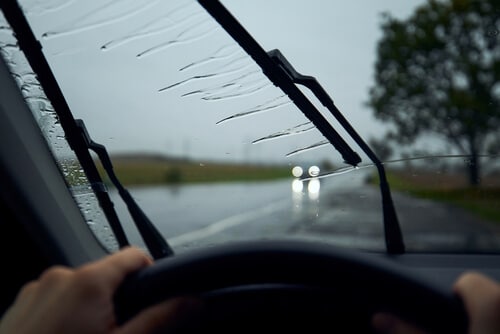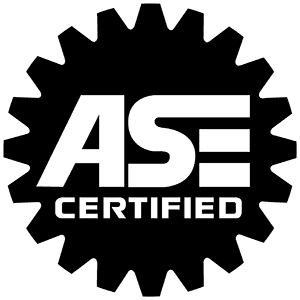Windshield Wipers and Headlights
Windshield wipers and headlights are two of the most important and underrated parts of your vehicle.
You need both in working service to pass your Texas vehicle inspection. Falling behind on your registration is no joke. So, if you know your headlights are out or your windshield wipers are falling apart, get down to a Kwik Kar Auto Services near you for replacements and repairs.
Kwik Kar Auto Services is your one-stop shop for all car repairs, including the most basic: windshield wipers or a broken headlight.
Windshield Wipers
Windshield wipers are made of synthetic polyisoprene or rubber and contain metal parts. Over time, the rubber can become brittle and cracked from exposure to the Texas sun and weather. The metal parts can also wear out and break.
When windshield wipers start to fail, they leave streaks and skips across the windshield. The wiper blades may not make full contact with the windshield, leaving unwiped areas that make it hard to see clearly during rain or snow.
Worn out wiper blades can even scratch the windshield glass. Windshield wipers wear out after about 12 months from regular use and exposure to the elements. The rubbing motion against the windshield over thousands of cycles wears down the edge of the wiper blade. Replacing them regularly as part of routine car maintenance can prevent windshield damage and dangerous conditions on the road.
Windshield Wiper Replacement at Kwik Kar
Many drivers perform windshield wiper replacement on their own within a few minutes. However, replacing your wiper blades is more than just snapping off the old and replacing them with the new.
Windshield wipers must be properly sized per your vehicle’s manual. Some drivers may not want to use their time looking up 22 versus 24-inch blades. That’s where we step in!
At Kwik Kar locations throughout Dallas-Fort Worth, Austin, or Houston we can change your wiper blades quickly at a reasonable price that leaves you feeling great when you hit the road.
Headlights, Brake Lights and Turn Signal Lights
Properly functioning headlights, brake lights, and turn signals are critical for safe driving. They serve as the main form of communication between drivers on the road.
Headlights illuminate the road ahead and make your vehicle visible to others in dark conditions. Working turn signals relay your intended movements to surrounding traffic.
From signaling lane changes, turns, merging, and other maneuvers your turn signals keep you in communication with other drivers when verbal communication isn’t possible.
Vehicles that lack functioning lights and signals are hazards, as other drivers cannot anticipate their movements. Driving without proper lights or signals greatly increases the risk of accidents and should be avoided. Working lighting systems are essential components of defensive driving.
Headlights Not Working?
Headlights are susceptible to a variety of problems that can lead to their failure. One of the most common issues is moisture buildup inside the headlight housing. Condensation can form inside the headlight, especially if there is a breach in the housing. This moisture can damage the bulb connection, causing the headlight to short out or flicker.
Even if the headlight is intact, humidity and temperature changes can still allow condensation to form inside.
Another frequent headlight issue is cloudy or oxidized headlight lenses. Plastic headlight lenses can become foggy and yellowed over time. Exposure to UV rays, dirt, and road debris causes the plastic to become opaque. This prevents the beam from shining through brightly, significantly reducing visibility.
The plastic lenses themselves can also get scratched, cracked, or damaged, allowing moisture and dirt to get inside.
Headlight bulb burnout is also a prevalent problem. Over time, the tungsten filament inside halogen bulbs degrades, causing them to burn out.
Electrical issues like loose or corroded wiring can cause bulbs to flicker and fail.
Replacing bulbs regularly before they burn out, keeping moisture out of housings, and restoring oxidized lenses are all important for maintaining visibility and safe driving conditions.
Wipers and Lights FAQ
Why are my headlights not working but high beams do?
This situation is likely the result of a faulty headlight relay. Each bean operates off of their own relay. Much like fuses, relays deteriorate with use and over time. You likely use your headlights more than high beams, so it’s common for headlight relays to fail before high beam relays.
How much does it cost to replace my headlights?
Headlight replacement costs, on average, between $60-$233 for parts and $100-$200 for labor.
How do I polish/clean my headlights?
Start by washing the headlights with soap and water to remove dirt and debris. Use a sponge or soft cloth to scrub the lenses gently. Avoid using abrasive cleaners or pads, which can further cloud the lenses.
If you’re experiencing heavy haze, restoration kits are available for purchase. These come with abrasive pads and polishing compounds to sand down the top layer of the lens and restore optical clarity.
After you’ve cleaned your headlights, apply a headlight sealant to protect the lenses from future cloudiness. The sealant fills in microscopic scratches and forms a protective barrier against UV rays.
How do you clean foggy headlights?
For moisture or condensation inside the headlight, you may need to replace the headlight housing or reapply weatherstripping to seal it. This prevents internal fogging and lets you benefit from a strong light during use.
Where can I fix a broken brake light?
If you have a broken brake light the team at a Kwik Kar repair center in DFW, Austin, or Houston, can help you get your brake light fixed at a great rate.
Is it legal to use LED headlights?
Colored LED headlights must have bulbs that are DOT or SAE approved. Any vehicle that does not have approved LED lights will not pass state inspection.
When should I replace windshield wiper blades?
We recommend replacing your windshield wiper blades every 12 months.
How do you change windshield wipers?
Changing windshield wiper blades is a simple task that can greatly improve your visibility while driving in rainy or snowy conditions. Here’s a step-by-step guide to help you replace your windshield wiper blades!
Before you start, make sure you have the correct replacement wiper blades for your vehicle. You can check your vehicle’s owner’s manual or consult with a knowledgeable auto parts store employee to ensure you get the right size and type.
Find a safe and level place to park your vehicle. Ensure that your windshield wipers are turned off, and the wiper arms are in the resting position.
Lift the wiper arms away from the windshield. Be careful not to let them snap back onto the glass, as they can damage your windshield.
Look for a small tab or button where the wiper blade connects to the wiper arm. Press or release this tab, depending on your wiper blade’s design.
Gently slide the old wiper blade down and away from the wiper arm to remove it.
Next, grab your new blade. Slide the new wiper blade onto the wiper arm, ensuring it’s securely attached to the arm’s hook or connector.
You should hear or feel a click when it’s properly attached.
Finally, carefully lower the wiper arm back to its normal position on the windshield.
What size windshield wipers do I need?
Before changing windshield wipers, always consult your vehicle’s manual to ensure you are putting on the right-sized blades for your car or truck.

New Windshield Wipers or Headlights
Whether you need new windshield wipers, a headlight replacement or the quickest, most efficient oil change in Texas, the team at Kwik Kar is ready to help you out!
Our experienced mechanics have the tools and expertise to help you resolve common vehicle maintenance needs and repairs that will get your wheels back on the road.
Our services are available throughout Dallas, Fort Worth, Austin, and Houston. Contact us today to learn more about our services or make an appointment.
Additional Auto Repair Services Available at Kwik Kar
If you need more than belt or hose replacement, we offer many car maintenance and repairs at our neighborhood Kwik Kars, including (alphabetical):



